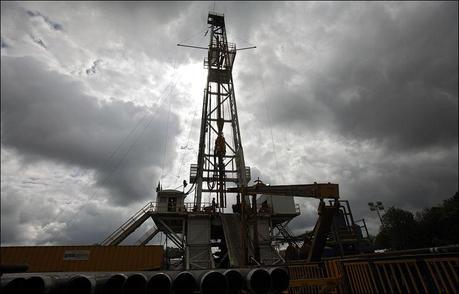
by Edward McAllister / Reuters
Recent small earthquakes in Ohio were likely triggered by fracking, state regulators said on Friday, a new link that could have implications for oil and gas drilling in the Buckeye State and beyond.
In the strongest wording yet from the state linking energy drilling and quakes, the Ohio Department of Natural Resources (ODNR) said that injecting sand, water and chemicals deep underground to help release oil and gas may have produced tremors in Poland Township last month.
The statement, in which the department announced stricter rules for oil and gas exploration in areas where seismic activity has occurred, comes after a steep rise in earthquakes in Ohio and other areas where intense drilling has taken place.
Most earthquakes occur naturally, but scientists have long linked some smaller tremors to oil and gas work underground, which can alter pressure points and cause shifts in the earth.
Last month, drilling and fracking was suspended near the site of two earthquakes in Poland Township in the northeast of the state, 70 miles southeast of Cleveland, the first of which was magnitude 3.0, enough to be felt for miles around.
Earthquakes rattled residents in Oklahoma last weekend, the latest in a series that have put the state on track for record quake activity this year, which some seismologists say may be tied to oil and gas exploration.
“Regarding the seismic events in Poland Township, ODNR geologists believe the sand and water injected into the well during the hydraulic fracturing process may have increased pressure on an unknown microfault in the area,” ODNR said in a statement.
Friday’s statement could have impacts not just for a state where a drilling boom is under way, but in other regions where concerns have emerged about the impact of fracking on fault lines. The new rules require a company to install seismic monitors if it is drilling within three miles of a known fault or an area which has recently experienced quakes, the ODNR said. It is unclear how much drilling will be affected by the new rules.
Hilcorp Energy, the company that was drilling near the quakes in Poland Township in March, cannot resume operations until it submits a new plan convincing regulators that drilling is safe, an agency spokesman said. Hilcorp was not immediately available to comment.
The department had not previously linked earthquakes to fracking, which involves fracturing rock by creating a series of small blasts thousands of feet below the surface, but the new data gave it “reasonable certainty” that fracking was the cause, the agency spokesman said.
“It is significant that they have acknowledged that there is a connection between fracking and earthquakes,” said Ray Beiersdorfer, professor of geology at Youngstown State University in Ohio.
The disposal of drilling wastewater in rockbed deep underground has been linked by geologists to earthquakes, sucah as the 4.0 magnitude one experienced on New Year’s Eve 2011 in Youngstown, but opinion is divided about whether fracking itself can cause quakes, and if it can trigger more than just small tremors.
While there are concerns about the environmental impact of injecting chemical-laced water into the ground, including on freshwater supplies, they are spreading to include the effect on fault lines than run beneath the surface, often undetected.
Worries surrounding seismic activity emerged in Ohio in 2011 when a spate of small quakes followed the beginning of intensive drilling in the Utica shale. More than 800 wells have been drilled in the Ohio portions of the Utica and the Marcellus shales, two major gas deposits that have helped transform the U.S. energy market. Once a regular importer of gas from overseas, the United States is set to export gas for the first time to countries across the globe.
“The steps announced today to protect communities from seismic events are reasonable precautions,” said Scott Anderson, a policy advisor at the Environmental Defense Fund. “Although there is much uncertainty regarding what causes earthquakes … the state’s decisive action is based on the best information available.”
(Reporting By Edward McAllister; Editing by Alden Bentley)

